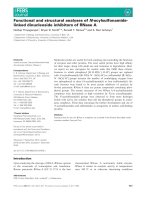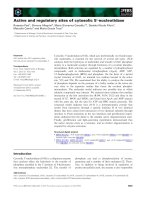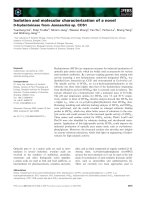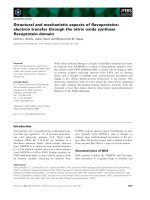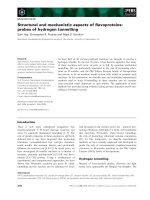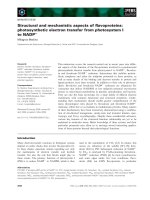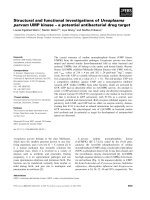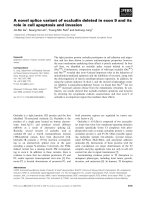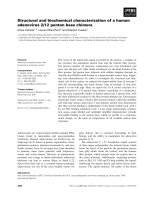Báo cáo khoa học: Protein and mRNA content of TcDHH1-containing mRNPs in Trypanosoma cruzi pdf
Bạn đang xem bản rút gọn của tài liệu. Xem và tải ngay bản đầy đủ của tài liệu tại đây (590.86 KB, 12 trang )
Protein and mRNA content of TcDHH1-containing
mRNPs in Trypanosoma cruzi
Fabı
´
ola B. Holetz
1
, Lysangela R. Alves
1
, Christian M. Pr obst
1
, Bruno Dallagiovanna
1
,FabricioK.Marchini
1
,
Patricio Manque
2,3
, Gregory Buck
2
,MarcoA.Krieger
1
, Alejandro Correa
1
and Samuel Goldenberg
1
1 Instituto Carlos Chagas ⁄ FIOCRUZ, Curitiba, Brazil
2 Center for the Study of Biological Complexity, Virginia Commonwealth University, Richmond, VA, USA
3 Instituto de Biotecnologia, Universidad Mayor, Santiago, Chile
Keywords
differentiation; P-bodies; stress granules;
translation control; Trypanosoma
Correspondence
S. Goldenberg, Instituto Carlos
Chagas ⁄ FIOCRUZ, Rua Professor Algacyr
Munhoz Mader 3775, Curitiba 81350-010
PR, Brazil
Fax: (55) 41 3316 3230
Tel: (55) 41 3316 3230
E-mail: sgoldenb@fiocruz.br
(Received 29 January 2010, revised 3 June
2010, accepted 23 June 2010)
doi:10.1111/j.1742-4658.2010.07747.x
In trypanosomatids, the regulation of gene expression occurs mainly at the
post-transcriptional level. Previous studies have revealed nontranslated
mRNA in the Trypanosoma cruzi cytoplasm. Previously, we have identified
and cloned the TcDHH1 protein, a DEAD box RNA helicase. It has been
reported that Dhh1 is involved in multiple RNA-related processes in vari-
ous eukaryotes. It has also been reported to accumulate in stress granules
and processing bodies of yeast, animal cells, Trypanosoma brucei and
T. cruzi. TcDHH1 is localized to discrete cytoplasmic foci that vary
depending on the life cycle status and nutritional conditions. To study the
composition of mRNPs containing TcDHH1, we carried out immunopre-
cipitation assays with anti-TcDHH1 using epimastigote lysates. The protein
content of mRNPs was determined by MS and pre-immune serum was
used as control. We also carried out a ribonomic approach to identify the
mRNAs present within the TcDHH1 immunoprecipitated complexes. For
this purpose, competitive microarray hybridizations were performed against
negative controls, the nonprecipitated fraction. Our results showed that
mRNAs associated with TcDHH1 in the epimastigote stage are those
mainly expressed in the other forms of the T. cruzi life cycle. These data
suggest that mRNPs containing TcDHH1 are involved in mRNA metabo-
lism, regulating the expression of at least epimastigote-specific genes.
Structured digital abstract
l
MINT-7909478: DHH1 (uniprotkb:Q4DIE1) physically interacts (MI:0915) with PABP2 (uni-
protkb:
Q27335)byanti bait coimmunoprecipitation (MI:0006)
l
MINT-7909338: DHH1 (uniprotkb:Q4DIE1) physically interacts (MI:0914) with ATP-depen-
dent DEAD ⁄ H RNA helicase, putative (uniprotkb:
Q4DIE1), Actin, putative (uniprotkb:
Q4D7A6), Actin, putative (uniprotkb:Q4CLA9), Chaperonin HSP60, mitochondrial (uni-
protkb:
Q4DYP6), ATP-dependent Clp protease subunit, heat shock protein 100 (HSP100),
putative (uniprotkb:
Q4CNM5), Elongation factor 2, putative (uniprotkb:Q4D5X0), Elonga-
tion factor 1-alpha (EF-1-alpha), putative (uniprotkb:
Q4CU73), Heat shock protein 85,
putative (uniprotkb:
Q4CQS6), Glutamate dehydrogenase, putative (uniprotkb:Q4DWV8),
Putative uncharacterized protein (uniprotkb:
Q4CNI8), 40S ribosomal protein S11, putative
(uniprotkb:
Q4CRH9), Sterol 24-c-methyltransferase, putative (uniprotkb:Q4CMB7), Heat
shock protein 70 (HSP70), putative (uniprotkb:
Q4DTM9), Glutamate dehydrogenase, puta-
tive (uniprotkb:
Q4D5C2) and Calpain-like cysteine peptidase, putative (uniprotkb:Q4CYU3)
by anti bait coimmunoprecipitation (
MI:0006)
l
MINT-7909469: DHH1 (uniprotkb:Q4DIE1) physically interacts (MI:0915) with PABP1
(uniprotkb:
Q4E4I9)byanti bait coimmunoprecipitation (MI:0006)
Abbreviations
eIF, eukaryotic initiation factor; IP, immunoprecipitated; MASP, mucin-associated surface protein; PABP, poly(A)-binding protein; P-bodies,
processing bodies; SG, stress granule; SP, supernatant.
FEBS Journal 277 (2010) 3415–3426 ª 2010 The Authors Journal compilation ª 2010 FEBS 3415
Introduction
The life cycle of the three trypanosomatid parasites
pathogenic to humans involves the alternation
between a mammal and an arthropod host. The two
main developmental stages of Trypanosoma brucei are
extracellular, in both mammalian host blood and the
tsetse fly intestine [1]. Trypanosoma cruzi exists in its
amastigote form in the cytoplasm of the mammal
infected cell, or as an epimastigote in the kissing bug
intestine [2]. Protozoans of the Leishmania genus, in
turn, multiply in the form of amastigotes within mac-
rophages and as extracellular promastigotes in the
insect vector [3]. The regulation of gene expression
thus plays a major role in determining the adaptation
and differentiation of these parasites throughout their
life cycle.
Trypanosomatids diverge from other eukaryotes in
several aspects, including the editing of mitochondrial
RNA molecules, trans-splicing, genes almost never
interrupted by introns and a lack of typical promoter
sequences for the transcription of protein-encoding
genes. In addition, transcription by RNA polymer-
ase II is constitutive and genes in the same polycis-
tronic unit display different levels of processed mRNA
[4–6]. Consequently, the regulation of gene expression
in trypanosomatids seems to occurs mainly post-trans-
criptionally [6,7].
When mRNAs enter the cytoplasm, they can be
translated, stored for later translation or degradation,
degraded or subjected to a combination of these
processes. In mammalian cells, mRNAs that are not
translated or destined for degradation are compart-
mentalized in distinct cytoplasmic structures, known as
‘processing bodies’ (‘P-bodies’) and stress granules [8–
10]. These RNA granules are key structures in the reg-
ulation of gene expression at the post-transcriptional
level [11–13]. Recently, we have identified the protein
TcDHH1, a putative DEAD box RNA helicase, in
T. cruzi, homologous to Dhh1 (yeast) and Rck ⁄ p54
(mammals) proteins [14]. It has been reported that
Dhh1 is involved in multiple RNA-related processes in
various eukaryotes, and accumulates in stress granules
and P-bodies of yeast, animal cells and T. brucei
(reviewed in [15–21]). Trypanosoma cruzi DHH1 is pres-
ent in polysome-independent complexes and is located
diffusely in the cytoplasm and in cytoplasmic granules,
which vary in number when the parasite is subjected to
nutritional stress or conditions interfering with the
translation process, e.g. treatment with cycloheximide
or puromycin [14].
In this article, we show that TcDHH1-containing
foci are present throughout the T. cruzi life cycle; how-
ever, they are less well defined in the infective metacy-
clic trypomastigote form. We also show that proteins
directly or indirectly associated with TcDHH1 include
those of diverse function, e.g. translation-related fac-
tors, cytoskeleton proteins, heat shock proteins and
metabolic proteins. We use a ribonomic approach to
identify the mRNA content of the TcDHH1-contain-
ing complexes. Microarray analyses reveal that the
mRNAs associated with TcDHH1 in the epimastigote
stage are some of those mainly expressed in the other
forms of the T. cruzi life cycle. These data suggest that
mRNPs containing TcDHH1 are involved in mRNA
metabolism, regulating the expression of, at least,
epimastigote-specific genes.
Results
TcDHH1-containing granules are present in all
developmental forms of T. cruzi
We have shown previously that, in epimastigotes,
TcDHH1 proteins are localized in discrete cytoplasmic
foci during the logarithmic growth phase and increase
in number under nutritional stress [14]. In this study,
we confirmed our previous data and also showed that
TcDHH1 is localized to cytoplasmic foci in adherent
parasites differentiating into metacyclic trypomastig-
otes and amastigotes. TcDHH1-containing granules
were not readily observed in trypomastigotes. This is
evident in microscopic fields in which terminally differ-
entiated metacyclic trypomastigotes and intermediate
forms are present (Fig. 1D). However, when the expo-
sure time for the photograph was at least doubled, a
few TcDHH1-containing granules were observed in
metacyclic trypomastigotes (data not shown). To a les-
ser extent, TcDHH1 was also observed diffusely in the
cytoplasm in all forms analyzed (Fig. 1). At least 10
random fields of each developmental form were ana-
lyzed, and more than 95% of the parasites had the
appearance described above.
Protein composition of TcDHH1-containing
complexes
Cytoplasmic complexes containing the protein
TcDHH1 in logarithmic growth phase epimastigotes
were immunoprecipitated with specific antiserum. As
seen by western blot analysis, the antiserum recognizes
a unique band of the expected mass size in a cyto-
plasmic extract of T. cruzi (Fig. 2). Pre-immune serum
was used as an experimental control. Three different
DHH1-mRNPs in Trypanosoma cruzi F. B. Holetz et al.
3416 FEBS Journal 277 (2010) 3415–3426 ª 2010 The Authors Journal compilation ª 2010 FEBS
immunoprecipitation experiments were performed.
Proteins associated with immunoprecipitated (IP) com-
plexes and proteins not associated with TcDHH1 from
the supernatant (SP) were resolved by SDS ⁄ PAGE and
visualized by silver staining (Fig. 3A). The IP and SP
samples obtained with pre-immune serum were pro-
cessed in the same way and are shown in Fig. 3C. To
provide a measure of the efficiency of TcDHH1 immu-
noprecipitation, IP and SP samples were loaded onto
an SDS ⁄ PAGE gel, transferred to a nitrocellulose
membrane, and immunoblotted with the TcDHH1
antibody (Fig. 3B). The results showed that different
protein profiles were obtained for the IP and SP silver-
stained gels (Fig. 3A, C). Western blot analysis using
the TcDHH1 antiserum allowed the identification of
the band corresponding to TcDHH1 (Fig. 3B), which
was not detected in the IP fraction obtained with the
pre-immune serum (Fig. 3D). The fact that TcDHH1
could also be detected in the SP fraction is probably a
A
B
Fig. 2. Western blot analysis of T. cruzi protein extracts using
anti-TcDHH1. (A) Western blot analysis of protein extracts from
epimastigotes (Epi), epimastigotes under nutritional stress (Stress),
differentiating epimastigotes (cells adherent after 24 h) (Ad24h),
metacyclic trypomastigotes (Meta) and amastigotes (Ama), probed
with antiserum against TcDHH1 protein (1 : 100 dilution). The
extracts were standardized and all lanes were loaded with 10 lgof
protein. (B) SDS ⁄ PAGE stained with Coomassie brilliant blue to
control protein load. TcDHH1 has an expected molecular mass of
46.7 kDa. The molecular mass marker (in kDa) is the Benchmark
Protein Ladder (Gibco, Grand Island, NY, USA).
A
B
C
D
E
Fig. 1. Localization of TcDHH1 during the life cycle of T. cruzi. (A)
Epimastigotes in logarithmic growth phase. (B) Epimastigotes under
nutritional stress. (C) Differentiating epimastigotes (24 h adherent
cells). (D) Metacyclic trypomastigotes. (E) Amastigotes. Cells were
incubated with antiserum against TcDHH1 and the immune com-
plexes were reacted with Alexa-labeled goat anti-mouse antibodies.
Kinetoplasts and nuclei were stained with propidium iodide. Open
arrowheads indicate an epimastigote form in the metacyclic trypo-
mastigote population. Filled arrowheads point to a trypomastigote
among the amastigotes. Bar, 10 lm.
F. B. Holetz et al. DHH1-mRNPs in Trypanosoma cruzi
FEBS Journal 277 (2010) 3415–3426 ª 2010 The Authors Journal compilation ª 2010 FEBS 3417
result of the abundance of TcDHH1, as inferred from
recent data from T. brucei [22].
IP proteins were digested with trypsin and
subjected to analysis by two-dimensional nano
LC-MS ⁄ MS. The mass spectra obtained were compared
with spectra deduced from protein sequences in the
T. cruzi data bank. We used the following criteria to
reliably select proteins from the database for further
analysis: (a) proteins with probability values equal
to or < 0.001; (b) proteins present in at least two
experiments using TcDHH1 antiserum; and (c) pro-
teins that did not appear in any of the three control
samples. Proteins that fulfilled the above criteria are
listed in Table 1 (for a complete list with all proteins
reliably identified in the immunoprecipitation assays,
but not meeting the selection criteria, see Table S1).
These complexes contain various proteins in addition
to TcDHH1, including heat shock proteins, mRNA-
binding proteins, initiation and elongation translation
factors, ribosomal proteins and metabolic proteins.
Abundant proteins, such as heat shock proteins and
elongation factor 1a, were present in the TcDHH1
immunoprecipitates, whereas other highly abundant
proteins, such as the cysteine proteinase cruzipain,
epimastigote-specific mucins and paraflagellar rod
proteins, were not detected in any of the experi-
ments.
TcDHH1 granules contain poly(A)-binding
proteins (PABPs)
As described previously, PABP1 is a core component
of stress granules in mammals [23]. Two PABPs with a
high similarity to other eukaryotic PABPs have been
identified previously in T. cruzi, TcPABP1 and
TcPABP2, with molecular masses of 63.8 and
61.4 kDa, respectively [24,25]. To test for the presence
of these proteins in TcDHH1 granules, epimastigotes
in the exponentially growing phase or under nutri-
tional stress were used for colocalization analyses.
PABP2 antiserum showed a punctate distribution in
the cytoplasm of epimastigotes and stressed epimastig-
otes. Most granules in these cells seemed to colocalize
with granules containing TcDHH1; those that did not
colocalize were grouped in defined regions of the cyto-
plasm lying next to each other (Fig. 4). Colocalization
assays with PABP1 antiserum showed a slightly differ-
ent staining pattern, with diffuse fluorescence and
some more intense fluorescent foci throughout the
cytoplasm. These foci partially colocalized with
TcDHH1 in both epimastigotes and epimastigotes
under nutritional stress (Fig. 4). In parallel with the
colocalization experiments, we carried out immunopre-
cipitation assays using mouse TcDHH1 antiserum, and
the presence of TcPABP1 and TcPABP2 proteins in
the precipitated complex was determined using western
blot analysis with rabbit LmPABP1 and LmPABP2
antisera (Fig. 5). Both antibodies specifically recog-
nized a single band with the expected molecular mass
in western blots, confirming that TcPABPs are part of
the TcDHH1 protein complex.
mRNAs present in TcDHH1-containing complexes
are regulated in a stage-specific manner
We used a ribonomic approach to identify the mRNAs
associated with TcDHH1, and thus to infer the role
CD
AB
Fig. 3. Analysis of TcDHH1 immunoprecipitation. (A) Epimastigote
proteins immunoprecipitated with TcDHH1 antibody (IP) and
proteins from the supernatant fraction (SP) were resolved by
SDS ⁄ PAGE and visualized by silver staining. (B) Western blot analy-
sis of IP and SP samples probed with antiserum against TcDHH1
protein (1 : 100 dilution), showing the efficiency of TcDHH1 immu-
noprecipitation. (C) Epimastigote proteins immunoprecipitated with
pre-immune serum (IP) and proteins from the supernatant fraction
(SP) were resolved by SDS ⁄ PAGE and visualized by silver staining.
(D) Western blot analysis of IP and SP samples, obtained with
pre-immune serum, and probed with serum against TcDHH1 pro-
tein (1 : 100 dilution). It should be noted that tracks in (C) and (D)
have a higher IgG background when compared with those in (A)
and (B) as pre-immune serum was used at a lower dilution in order
to discard the spurious recognition of TcDHH1. The molecular mass
marker (in kDa) is the Benchmark Protein Ladder (Gibco).
DHH1-mRNPs in Trypanosoma cruzi F. B. Holetz et al.
3418 FEBS Journal 277 (2010) 3415–3426 ª 2010 The Authors Journal compilation ª 2010 FEBS
played by this protein in the regulation of gene expres-
sion in T. cruzi. The mRNAs associated with IP com-
plexes from epimastigotes were compared with the
mRNAs not associated with TcDHH1 from SP. IP
and SP samples were obtained from six experiments,
and were compared using competitive hybridization
assays in oligo-DNA microarrays. The amount of
RNA extracted from IP samples was generally smaller
than that from SP samples. This was expected, as the
mRNA population associated directly or indirectly
with TcDHH1 is likely to represent only a fraction of
the total RNA.
We identified mRNAs that were present in IP and
SP samples in different amounts, based on a two-fold
difference in mRNA levels and a 5% false discovery
rate. For epimastigote forms in the logarithmic growth
phase, 203 distinct mRNAs displayed higher levels in
the IP than SP fraction, with 265 mRNAs present at
lower levels in the SP sample. Most of the mRNAs
associated with TcDHH1 were from mucin-associated
surface protein (MASP) and mucin protein families,
with others corresponding to several hypothetical and
hypothetical conserved proteins. We also observed
mRNAs corresponding to metabolic proteins, mRNA-
binding proteins, amastin and cyclin, among others
(Fig. 6A, Table 2) (for a detailed list of mRNAs, see
Table S2). A semi-quantitative approach, RT-PCR
and densitometry analysis of gel bands for five
mRNAs with different distribution patterns between
IP and SP samples confirmed these results (Fig. 6B).
Surface proteins (MASP and mucins) are encoded by
multigene families. Although these gene families were
the largest in the T. cruzi genome, we did not identify
any of the corresponding mRNAs in the SP sample,
demonstrating the specific presence of these mRNAs in
the IP sample. Moreover, mRNAs from other large
gene families in T. cruzi, e.g. those encoding trans-siali-
dase and cysteine protease, were not found in the IP
sample.
Discussion
Recently, we have identified a putative RNA helicase
(TcDHH1), which is similar to its eukaryotic orthologs
[14]. Members of this protein family are involved in
several aspects of mRNA metabolism and localize to
distinct foci in the cytoplasm [26]. We compared the
replicative, nutritionally stressed, differentiating and
infective forms of T. cruzi, and showed that these
T. cruzi life cycle stages display distinct granular pat-
terns of cytoplasmic TcDHH1-containing foci (Fig. 1).
These granules were not as clearly visible in trypom-
astigotes as in the other forms, but TcDHH1 protein
levels remained similar for all T. cruzi developmental
stages [14]. Thus, the variation in the number of
TcDHH1-containing granules does not seem to be
related to changes in gene expression levels, but is
probably related to diffuse or foci-like distributions. In
a recent study, Cassola et al. [20] showed that epim-
astigotes in culture and parasites at different time
points during in vitro differentiation did not display
mRNA granules. Although, at first, these findings
seem to disagree with our work, it is not possible to
compare these studies because different experimental
approaches were used to investigate the presence of
mRNA granules in developmental forms of T. cruzi.
Table 1. Protein composition of TcDHH1-containing complexes. IP, complexes immunoprecipitated with anti-TcDHH1 antibody; C, complexes
immunoprecipitated with pre-immune serum; 1, 2, 3, biological replicates; •, indicates the presence of a protein in that fraction.
Protein description IP1 IP2 IP3 C1 C2 C3
Tc00.1047053510127.79 actin, putative ••
Tc00.1047053510573.10 actin, putative ••
Tc00.1047053507641.280 Cnp60 chaperonin HSP60, mitochondrial precursor; groELprotein; heats ••
Tc00.1047053508665.14 ATP-dependent Clp protease subunit, heat shock protein 100,putative ••
Tc00.1047053508169.20 elongation factor 2, putative •••
Tc00.1047053508949.4 elongation factor 1a (EF-1a), putative •••
Tc00.1047053507713.30 heat shock protein 85, putative •••
Tc00.1047053507875.20 glutamate dehydrogenase, putative ••
Tc00.1047053508111.30 glutamate dehydrogenase, putative ••
Tc00.1047053509139.10 hypothetical protein, conserved ••
Tc00.1047053511139.20 40S ribosomal protein S11, putative ••
Tc00.1047053506983.39 calpain-like cysteine peptidase, putative ••
Tc00.1047053504191.10 sterol 24-c-methyltransferase, putative ••
Tc00.1047053511211.160 heat shock protein 70 (HSP70), putative ••
Tc00.1047053506959.30 ATP-dependent DEAD ⁄ H RNA helicase, putative ••
F. B. Holetz et al. DHH1-mRNPs in Trypanosoma cruzi
FEBS Journal 277 (2010) 3415–3426 ª 2010 The Authors Journal compilation ª 2010 FEBS 3419
In yeast, the Dhh1 protein interacts with decapping
and deadenylation complexes, stimulating mRNA
decapping [15–18]. Dhh1p homologs from Caenorhabd-
itis elegans (Cgh1), Drosophila (Me31b) and Xenopus
(Xp54) are involved in the storage of translationally
repressed maternal mRNAs [16,17]. In addition, the
RNA helicase DOZI, involved in the storage and
silencing of certain mRNA species, has been identified
recently in Plasmodium berghei and is localized to cyto-
plasmic granules in female gametocytes [19].
Dhh1 ⁄ Rckp54 is common to both P-bodies and stress
granules [10–13]; both of these types of granule may
therefore exist in T. cruzi. Therefore, we studied
mRNPs containing TcDHH1 and investigated their
potential similarity with mRNPs in other organisms.
We have shown previously that TcDHH1 is present in
cytoplasmic complexes containing mRNA and pro-
teins. TcDHH1-containing complexes have been puri-
fied previously from polysome and polysome-free
fractions [27]. TcDHH1 must therefore be, at least
partly, associated with mRNAs that are independent
of the translation machinery.
Our analysis of IP complexes showed that TcDHH1
interacts with proteins that are described as stress
granule components (SGs). We identified TcDHH1, as
expected, and proteins previously identified in stress
granules, such as heat shock proteins and 40S ribo-
somal subunit proteins. Translation initiation factors
(eukaryotic initiation factors 3 and 4, eIF3 and eIF4),
also typical of SGs, were observed in one of the three
A
B
Fig. 4. Colocalization assays of PABP
proteins with TcDHH1. (A) Logarithmic
growth phase epimastigotes. (B) Epimastig-
otes under nutritional stress. Antibodies
against PABP1 and PABP2 were produced
in rabbit and tested at 1 : 100 dilutions.
Antibodies against TcDHH1 protein were
produced in mouse and used at 1 : 100
dilution. Immune complexes reacted with
Alexa-labeled 546 goat anti-rabbit and
Alexa-labeled 488 goat anti-mouse antibod-
ies (1 : 400). Bar, 10 lm.
DHH1-mRNPs in Trypanosoma cruzi F. B. Holetz et al.
3420 FEBS Journal 277 (2010) 3415–3426 ª 2010 The Authors Journal compilation ª 2010 FEBS
biological replicates (Table S1). Although abundant
proteins, such as heat shock proteins and eIF1a, are
present in these complexes, other proteins highly abun-
dant in epimastigotes, such as the cysteine proteinase
cruzipain, the family of GP63 metalloproteases, many
ribosomal proteins, epimastigote-specific mucins and
the epimastigote-specific metabolic protein histidine
ammonia-lyase, were not detected in any of the experi-
ments [28–30]. Nonetheless, it remains to be elucidated
whether these proteins indeed interact with TcDHH1
or are fraction contaminants. Interestingly, Pare et al.
[31] have revealed recently that a heat shock protein
(Hsp90) is important for recruiting the argonaute
protein ( hAgo2) to SGs and for efficient biogenesis and ⁄
or stability of P-bodies in mammals. Thus, it seems
probable that the heat shock proteins identified in our
study might interact with TcDHH1. We also identified
proteins that are not characteristic of these structures,
such as translation elongation factors, metabolic
proteins and actin (Table 1). Although actin is not a
AB
Fig. 6. mRNAs present in TcDHH1-containing complexes in epimastigotes. (A) Pie chart diagram displaying the percentage representation of
the most abundant mRNAs present in TcDhh1-containing complexes. (B) RT-PCR analysis of five mRNAs with different distribution patterns
between IP and SP fractions. Putative glucose-regulated protein 78, more represented in the SP fraction, showed an IP ⁄ SP ratio of 0.51.
Putative (H+)-ATPase G subunit, equally represented in both fractions, resulted in an IP ⁄ SP ratio of 0.98. Putative cyclin, putative mucin
TcMUCII and hypothetical protein were more represented in the IP fraction, with IP ⁄ SP ratios of 2.0, 6.7 and 1.8, respectively.
AB
Fig. 5. Co-immunoprecipitation assays of TcDHH1 with PABP pro-
teins. Epimastigote proteins were immunoprecipitated with mouse
TcDHH1 antibody (I) or pre-immune serum (PI), resolved by
SDS ⁄ PAGE, electrotransferred onto Hybond-C membranes and
probed with rabbit anti-LmPABP1 (A) and anti-LmPABP2 (B) anti-
sera (1 : 100 dilution), showing that PABPs are part of the TcDHH1
protein complex. The molecular mass marker (in kDa) is the Bench-
mark Protein Ladder (Gibco).
Table 2. mRNAs present in TcDHH1-containing complexes in
epimastigotes.
Gene description No. of genes
Mucin-associated surface protein (MASP), putative 61
Mucin-associated surface protein (MASP,
pseudogene), putative
4
Mucin TcMUCII, putative 52
Mucin TcMUCII (pseudogene), putative 3
Mucin TcSMUGS, putative 1
Hypothetical protein, conserved 31
Hypothetical protein 34
ADP-ribosylation factor family, putative 1
Amastin, putative 1
Cyclin, putative 1
Expression site-associated gene (ESAG-like)
protein, putative
1
Meiotic recombination protein SPO11, putative 1
Mitochondrial carrier protein, putative 1
Nucleoside transporter 1, putative 1
Phosphatidic acid phosphatase, putative 1
Protein kinase, putative 1
Ras-related GTP-binding protein, putative 1
RNA-binding protein 5, putative 1
RNA-binding protein, putative 1
Serine acetyltransferase, putative 1
Serine ⁄ threonine protein phosphatase, putative 1
Serine ⁄ threonine protein phosphatase 2A,
catalytic subunit, putative
1
Serine-, alanine- and proline-rich protein, putative 1
Trypanothione synthetase, putative 1
F. B. Holetz et al. DHH1-mRNPs in Trypanosoma cruzi
FEBS Journal 277 (2010) 3415–3426 ª 2010 The Authors Journal compilation ª 2010 FEBS 3421
typical SG, there seems to be a close interaction
between cytoplasmic mRNA granules and the cytoskel-
eton. Indeed, granules remaining motionless are associ-
ated with actin filaments, whereas those that move in
the cytoplasm remain associated with microtubules
[32]. Thus, it is possible that actin is indeed a compo-
nent of TcDHH1-containing complexes and not a
putative contaminant. The fact that other abundant
proteins were not detected in this fraction would be
consistent with this. Interestingly, we did not identify
P-body core proteins, such as LSMs and exonuclease
5¢–3¢ XRN1. These findings suggest that TcDHH1-
containing complexes are more likely to be compo-
nents of SGs than of P-bodies. We cannot rule out the
possibility that the identified proteins of TcDHH1-con-
taining complexes also correspond to the cytoplasmic
granule-free fraction of TcDHH1.
We tested for the colocalization of TcDHH1 with
PABP present in stress granules to extend our findings
from the immunoprecipitation experiments and to gain
further insight into the function of TcDHH1-contain-
ing granules. Our results suggest that TcDHH1-
containing granules contain PABPs. Indeed, PABP2
seemed to colocalize with most granules containing
TcDHH1 in both unstressed epimastigotes and epi-
mastigotes subjected to nutritional stress. Granules
appearing to contain only PABPs remained adjacent
to these TcDHH1-containing granules (Fig. 4).
Our findings are in agreement with the data pub-
lished by Cassola et al. [20], who demonstrated that, in
starved parasites, TcPABP1 and TcPABP2 showed
strong accumulation in mRNA granules. However, in
contrast with our study, these authors showed that
TcPABP1 and TcPABP2 were not recruited to mRNA
granules in parasites not subjected to starvation. One
possible explanation for this difference is the fact that
these authors used parasites overexpressing green fluo-
rescent protein fusions, in contrast with the native pro-
teins evaluated here. PABP1 is used as a marker for
stress granules and is absent from P-bodies in mam-
mals. However, Brengues and Parker [33] showed that
PABP1 is present in the P-bodies of Saccharomyces
cerevisiae, and that mRNPs containing poly(A)
+
mRNA, PABP1, eIF4E and eIF4G enter these struc-
tures, possibly representing a transitional state during
mRNA exchange between P-bodies and the translation
machinery. These authors also demonstrated that
PABP1 may be present in P-bodies even in the absence
of stress. Another study demonstrated that granules
containing PABP1 in S. cerevisiae were distinct from
the P-bodies formed specifically under stress caused by
glucose deprivation, and that these two types of gran-
ule partially colocalize. These granules may function as
mRNA storage compartments, called EGP-bodies,
allowing mRNA translation to resume when cell
growth conditions are restored, and are analogous to
the stress granules observed in mammals [34].
The characterization of mRNAs from mRNP com-
plexes immunoprecipitated with TcDHH1 antiserum
revealed the presence of several mRNA species, with
overrepresentation of those encoding MASP, mucins,
hypothetical proteins and amastin. In general, mRNAs
associated with TcDHH1 are not translated into pro-
teins in epimastigotes, but are predominantly trans-
lated during other stages of the parasitic life cycle. For
example, TcMUCII proteins are specific to, and
MASP proteins are mostly produced in, the trypomas-
tigote forms [35,36]. The mRNA encoding amastin, a
protein predominantly produced in amastigotes [37],
was also present in the TcDHH1-containing complexes
from epimastigotes. These findings suggest that epi-
mastigote TcDHH1-associated mRNAs are either
stored for later use or are present in the initial steps to
degradation, given that their poly(A) tails are mostly
intact. Accordingly, recent work using an ATPase-defi-
cient dhh1 mutant provided evidence that a pathway
including Dhh1 has a selective role in the destabiliza-
tion of many regulated mRNAs in procyclic forms of
T. brucei [22].
It should be noted that the ribonomic approach used
in this study favors the identification of polyadenylated
mRNAs present in IP complexes; deadenylated mRNAs
destined for, or in the initial stages of, degradation
would not be detected by these microarray analyses.
Materials and methods
Parasites
The T. cruzi clone Dm28c [38] was maintained at 28 °Cin
liver infusion tryptose medium supplemented with 10%
heat-inactivated fetal bovine serum. Epimastigotes under
nutritional stress, metacyclic trypomastigotes and amastig-
otes were obtained in vitro as described previously [39,40].
Immunofluorescence and imaging
Immunofluorescence assays were carried out using a proto-
col described previously [14], which was modified slightly to
ensure that parasites were resuspended and washed in
NaCl ⁄ P
i
for only 5 min before being fixed.
Mouse polyclonal anti-TcDHH1 antibody was produced
as described previously [14]; the antiserum was affinity puri-
fied and stored in aliquots at )20 °C prior to use. Rabbit
polyclonal antibodies against PABP1 and PABP2 were
kindly provided by Dr Osvaldo P. de Melo Neto (Centro
DHH1-mRNPs in Trypanosoma cruzi F. B. Holetz et al.
3422 FEBS Journal 277 (2010) 3415–3426 ª 2010 The Authors Journal compilation ª 2010 FEBS
de Pesquisas Aggeu Magalha
˜
es, Fiocruz, Recife, Brazil).
Serum dilutions of antibodies were as follows: rabbit
anti-LmPABP1 and anti-LmPABP2, 1 : 100; mouse anti-
TcDHH1, 1 : 100. Alexa Fluor-488 and Alexa Fluor-546
were used as conjugated secondary antibodies (1 : 400;
Molecular Probes, Invitrogen, Eugene, OR, USA). Images
showing subcellular localization were acquired using a
Nikon Eclipse E600 microscope (Nikon Corporation,
Tokyo, Japan) coupled to a Cool SNAP-PRO color camera
(Media Cybernetics, Bethesda, MD, USA). Merged images
were obtained by superimposing image files with image-pro
plus software (Media Cybernetics).
DHH1 immunoprecipitation assays: protein
content
Immunoprecipitation assays with the anti-TcDHH1 anti-
body were carried out in cytoplasmic extracts from loga-
rithmic growth phase epimastigotes. Mouse anti-TcDHH1
(50 lL) was incubated with 150 lL of resin containing pro-
tein G Sepharose (Sigma) for 8 h at 4 °C, with moderate
stirring. Pre-immune serum was incubated with resin under
the same conditions and used as a control for immunopre-
cipitation reaction specificity. After incubation, the resin
was collected by centrifugation at 600 g for 2 min, the
supernatant was discarded and the resin was incubated with
5% nonfat milk in NaCl ⁄ P
i
for 30 min. The resin was then
washed twice with NaCl ⁄ P
i
.
To obtain T. cruzi cytoplasmic extracts, 2 · 10
9
parasites
were washed with NaCl ⁄ P
i
and incubated in 2 mL of IMP1
buffer (KCl, 100 mm; MgCl
2
,5mm; Hepes, 10 mm,
pH 7.0; protease inhibitor, 1 : 100; RNase OUT,
200 UÆmL
)1
; Nonidet P40, 0.5%) for 2 h on ice, with mod-
erate agitation. Parasite lysis was monitored with a light
microscope. Cytoplasmic extracts were obtained by centri-
fugation at 7000 g for 20 min at 4 °C; 1 mL of this extract,
corresponding to the lysis of 1 · 10
9
parasites, was incu-
bated with resin previously coupled to anti-TcDHH1 anti-
body or to the pre-immune serum, as described above, for
16 h at 4 °C, with moderate agitation.
The IP complexes were collected by centrifugation at
600 g for 2 min and SPs were saved. The resin was washed
three times with IMP2 buffer (KCl, 100 mm; MgCl
2
,5mm;
Hepes, 10 mm, pH 7.0; protease inhibitor, 1 : 100; RNase
OUT, 200 UÆmL
)1
; Nonidet P40, 1%), followed by the
same centrifugation step. Proteins linked to the resin were
eluted with 150 lL of glycine (0.1 m, pH 2.0) and the pH
was adjusted to 7.5–8.0. Next, 150 lL of buffer (urea, 7 m;
thiourea, 2 m; Chaps, 2%; Triton, 2%; dithiothreitol, 1%;
nuclease, 1 : 100; protease inhibitor, 1 : 100) was added to
the sample and proteins were analyzed by two-dimensional
nano LC-MS ⁄ MS. Fifty micrograms of protein were puri-
fied before analysis using a two-dimensional clean-up kit,
following the manufacturer’s instructions (GE Healthcare,
Buckinghamshire, UK). Proteins were reduced with dith-
iothreitol, alkylated with iodoacetamide and digested over-
night with trypsin. The resulting tryptic peptides were
desalted on C8 cartridges (Michrom BioResources, Auburn,
CA, USA) and subjected to two-dimensional nano
LC ⁄ MS ⁄ MS analyses on a Michrom BioResources Paradigm
MS4 Multi-Dimensional Separations Module, a Michrom
NanoTrap Platform and an LCQ Deca XP plus ion trap mass
spectrometer. The mass spectrometer was used in data-depen-
dent mode, and the four most abundant ions in each mass
spectrum were selected and fragmented to produce tandem
mass spectra. The MS ⁄ MS spectra were recorded in the pro-
file mode. Proteins were identified by comparing the MS ⁄ MS
spectra obtained with our T. cruzi database and its reversed
complement using Bioworks v3.2. Peptide and protein hits
were scored and ranked using the probability-based scoring
algorithm incorporated in Bioworks v3.2 and adjusted to a
false positive rate of less than 1%. Only peptides showing
fully tryptic termini, with cross-correlation scores (X
corr
)
greater than 1.9 for single-charged peptides, 2.3 for double-
charged peptides and 3.75 for triple-charged peptides, were
used for peptide identification. In addition, delta correlation
scores (DC
n
) were set to be > 0.1 and, for increased strin-
gency, proteins were accepted only if their probability score
was less than 0.001. The following search parameters were
used: taxonomy, eukaryota; monoisotopic mass tolerance,
0.1 Da; partial methionine oxidation; and one missed tryptic
cleavage allowed. Criteria for positive protein identification
included Mascot scores and sequence coverage.
Parallel to MS, IP and SP samples were analyzed by
SDS ⁄ PAGE. Gels were silver stained according to the
following protocol: incubation in fixing solution (50%
ethanol, 12% acetic acid, 0.02% formaldehyde) for 1 h,
three washes in 50% ethanol for 15 min and sensibilization
in 0.02% sodium thiosulfate for 1 min, followed by an
extensive wash in distilled water. Staining was performed
by incubating the gel for 30 min in silver nitrate solution
(0.2% silver nitrate, 0.02% formaldehyde), followed by
washing three times in distilled water for 1 min. The gel
was developed in 3% sodium carbonate and 0.05% formal-
dehyde. Staining was stopped in 50% ethanol and 12% ace-
tic acid for 5 min. For western blot analysis, IP and SP
samples were separated on a 13% SDS ⁄ PAGE gel and
transferred to a nitrocellulose membrane. Nonspecific bind-
ing sites were blocked by incubating the membrane with
5% nonfat milk powder and 0.1% Tween-20 in NaCl ⁄ P
i
for 30 min. For analysis of the efficiency of TcDHH1
immunoprecipitation, membranes were incubated for 1 h
with anti-TcDHH1 antibody (1 : 100 dilution) or with pre-
immune serum. For co-immunoprecipitation analysis of
TcDHH1 and TcPABPs, membranes were incubated for
1 h with rabbit anti-LmPABP1 and anti-LmPABP2 (1 : 100
dilution). The membranes were then extensively washed in
NaCl ⁄ P
i
and incubated with goat phosphatase-conjugated
anti-rabbit IgG (Sigma) diluted 1 : 10 000. The color
reaction was developed with 5-bromo-4-chloro-3-indolyl
F. B. Holetz et al. DHH1-mRNPs in Trypanosoma cruzi
FEBS Journal 277 (2010) 3415–3426 ª 2010 The Authors Journal compilation ª 2010 FEBS 3423
phosphate and nitroblue tetrazolium (Promega, Fitchburg,
WI, USA).
DHH1 immunoprecipitation assays: ribonomics
To determine which mRNAs were associated with the
TcDHH1 protein ⁄ complexes, anti-TcDHH1 was incubated
with resin containing protein A Sepharose (Sigma) for
16 h at 4 °C with agitation. Antiserum (150 lL) was
mixed with 150 lL of resin and 1 lL of RNAse OUT
(Invitrogen). After incubation, the resin was collected by
centrifugation and processed as described above. Cyto-
plasmic extract, corresponding to 2 · 10
9
cells, was incu-
bated with resin previously linked to anti-TcDHH1
antibodies for 2 h in an ice bath, with agitation. The
resin was then collected by centrifugation and SP was
retained for a control. Resin was washed three times with
IMP2 buffer. The RNAs from the SP or resin (IP) were
purified with an RNeasy
Ò
(Qiagen, Hilden, Germany) kit
using the ‘Animal Cells I’ protocol in the manufacturer’s
manual, with the additional step of DNase treatment in
a column. Linearly amplified RNA was generated from
1 lg of total RNA (single round) using a MessageAmp
amplified RNA kit (Ambion, Austin, TX, USA), follow-
ing the manufacturer’s instructions. cDNA was synthe-
sized from 1 lg of total or affinity-purified RNA using
an oligo(dT) primer (US Biochemical Corporation, Cleve-
land, OH, USA) and reverse transcriptase (IMPROM II;
Promega), as recommended.
Oligonucleotide DNA microarrays
The microarray was constructed with 70-mer oligonucleo-
tides. As a result of the hybrid and repetitive nature of the
sequenced T. cruzi strain (CL Brener), all coding regions
(CDS) identified in the genome (version 3) were retrieved
and clustered using the blastclust program, with 40%
coverage and 75% identity. For the probe design, array-
oligoselector software (v. 3.8.1) was used, with 50% GC
content; 10 359 probes were designed to the longest T. cruzi
CDS of each cluster; 393 probes correspond to genes of an
external group (Cryptosporidium hominis) and 64 spots con-
tain only spotting solution (NaCl ⁄ Cit, 3 ·), totaling 10 816
spots. These oligonucleotides were spotted from a 50 lm
solution onto poly-l-lysine-coated slides and cross-linked
with 600 mJ UV. Each probe corresponding to T. cruzi
genes was identified following the T. cruzi Genome Consor-
tium annotation (). The microarray
slides were produced at Virginia Commonwealth Univer-
sity, Richmond, VA, USA.
Microarray hybridization and analysis
Fluorescent cyanin (Cy) dyes, Cy3 or Cy5 as appropriate,
were incorporated into second-strand cDNA synthesis using
2 lg of amplified RNA as the starting material for each
sample. Labeled cDNA was purified with a Microcom 30
device (Millipore, Carrigtwohill, Ireland). Microarray
hybridizations and washes were carried out in a GeneTac
automated hybridization station (Genomic Solutions,
Chelmsford, MA, USA). The Cy3- and Cy5-labeled cDNAs
were mixed and added to 120 lL of hybridization solution
and allowed to hybridize for 14–16 h at 42 °C. The micro-
array slides were then washed in buffer of increasing strin-
gency (0.5 · and 0.05 · NaCl ⁄ Cit) and dried by
centrifugation at 280 g for 5 min. The dried slides were
scanned in a 428 Array Scanner (Affymetrix, Santa Clara,
CA, USA). The images were analyzed with spot software.
The resulting data were corrected for background and nor-
malized, using the normexp and PrintTip-Loess methods,
respectively, within the Limma package [41].
A total of six individual IP and SP pairs was hybridized
in a semi-balanced dye design; overrepresented genes from
both fractions were selected using sam software [42]. Genes
were thus selected on the basis of at least a two-fold differ-
ence in mRNA levels and a 5% false discovery rate. Micro-
array data were submitted to ArrayExpress accession
number E-MEXP-2448.
RT-PCR
cDNA was synthesized from 1 lg of total RNA using 1 lL
of 10 lm random primers (USB Corporation, Cleveland,
OH, USA) and 1 lL of reverse transcriptase (IMPROM II;
Promega), according to the manufacturer’s instructions.
PCR was carried out with 20 ng of cDNA as template,
20 mm Tris-HCl (pH 8.4), 10 pmol of primers, 2.5 mm
MgCl
2
, 0.0625 mm dNTPs and 1 U Taq polymerase
(Invitrogen). The oligonucleotide primer sets used for PCR
were as follows: putative cyclin (Tc00.1047053506945.270),
F, 5¢-TGGGGAGGATTATAGCGATG-3¢;R,5¢-ACTTC
GGCAGAGCACTTCAT-3¢; putative mucin TcMUCII
(Tc00.1047053506131.20),F,5¢-GCGGAGAACAAGATG
AGGA-3¢;R,5¢-TCGCTTTTGAAATAGGCACC-3¢;
hypothetical protein (Tc00.1047053509891.40),F,5¢-GCCG
TCATGCAAAAATATCC-3¢;R,5¢-CCTTTTCAGCCAA
AAAGCTG-3¢; putative glucose-regulated protein 78
(Tc00.1047053506585.40),F,5¢-TGGCGGTAAGAAGAA
GCAGT-3¢;R,5¢-CCGAGGTCAAACACAAGGAT-3¢;
putative (H+)-ATPase G subunit (Tc00.1047053510993.
10),F,5¢-ACAACGTGCAAAGGCTTCTT-3 ¢;R,5¢-CTC
GTGCCAACTCCAAGTTT-3¢.
PCR, using a Bio-Cycler II thermocycler (Peltier Thermal
Cycler; Bio-Rad, Hercules, CA, USA), included heating at
94 °C for 2 min, followed by 25 cycles of 94 °C for 15 s,
58 °C for 30 s and 72 °C for 30 s, with a final extension of
72 °C for 3 min. Ten microliters of RT-PCR products were
resolved by 2% agarose gel electrophoresis, visualized by
ethidium bromide staining. Gel photographs were taken
using a UVP Bioimaging System (UVP, Upland, CA,
DHH1-mRNPs in Trypanosoma cruzi F. B. Holetz et al.
3424 FEBS Journal 277 (2010) 3415–3426 ª 2010 The Authors Journal compilation ª 2010 FEBS
USA), and densitometry analysis of bands was performed
using the Kodak 1DScientific Imaging System v.3.5.2
program (Kodak, Rochester, NY, USA). The ratio of the
densitometric values of the bands containing amplified
cDNA between IP and SP samples was determined.
Acknowledgements
We thank Andreia Dallabona, Nilson Fideˆ ncio and
Crisciele Kuligovski for skillful technical assistance, Dr
Osvaldo Pompilio de Melo Neto for PABP antibodies
and Dr Andrea Rodrigues A
´
vila for helpful suggestions
and discussion of the manuscript. This investigation
received financial support from Conselho Nacional de
Desenvolvimento Cientı
´
fico e Tecnolo
´
gico (CNPq) and
Fundac¸ a
˜
o Oswaldo Cruz (PAPES-CNPq-Fiocruz).
References
1 Fenn K & Matthews KR (2007) The cell biology of
Trypanosoma brucei differentiation. Curr Opin Microbiol
10, 539–546.
2 De Souza W (2002) Basic cell biology of Trypanosoma
cruzi. Curr Pharm Des 8, 269–285.
3 Cohen-Freue G, Holzer TR, Forney JD & McMaster
WR (2007) Global gene expression in Leishmania. Int
J Parasitol 37, 1077–1086.
4 Clayton CE (2002) Life without transcriptional control?
From fly to man and back again EMBO J 21, 1881–1888.
5 El-Sayed NM, Myler PJ, Blandin G, Berriman M,
Crabtree J, Aggarwal G, Caller E, Renauld H, Worthey
EA & Hertz-fowler C (2005) Comparative genomics of
trypanosomatid parasitic protozoa. Science 309, 404–409.
6 Clayton C & Shapira M (2007) Post-transcriptional
regulation of gene expression in trypanosomes and
leishmanias. Mol Biochem Parasitol 156, 93–101.
7 Haile S & Papadopoulou B (2007) Developmental regu-
lation of gene expression in trypanosomatid parasitic
protozoa. Curr Opin Microbiol 10, 569–577.
8 Kedersha N, Stoecklin G, Ayodele M, Yacono P,
Lykke-Andersen J, Fritzler MJ, Scheuner D, Kaufman
RJ, Golan DE & Anderson P (2005) Stress granules
and processing bodies are dynamically linked sites of
mRNP remodeling. J Cell Biol 169, 871–874.
9 Parker R & Sheth U (2007) P bodies and the control of
mRNA translation and degradation. Mol Cell 25, 635–
646.
10 Balagopal V & Parker R (2009) Polysomes, P bodies
and stress granules: states and fates of eukaryotic
mRNAs. Curr Opin Cell Biol 21, 403–408.
11 Anderson P & Kedersha N (2006) RNA granules. J Cell
Biol 172, 803–808.
12 Anderson P & Kedersha N (2007) Stress granules:
the Tao of RNA triage. Trends Biochem Sci 33, 141–150.
13 Eulalio A, Behm-Ansmant I & Izaurralde E (2007)
P bodies: at the crossroads of post-transcriptional path-
ways. Mol Cell Biol 8, 9–22.
14 Holetz FB, Correa A, Avila AR, Nakamura CV, Krie-
ger MA & Goldenberg S (2007) Evidence of P-body-like
structures in Trypanosoma cruzi. Biochem Biophys Res
Commun 356, 1062–1067.
15 Ladomery M, Wade E & Sommerville J (1997) Xp54,
the Xenopus homologue of human RNA helicase p54, is
an integral component of stored mRNP particles in
oocytes. Nucleic Acids Res 25, 965–973.
16 Tcker M, Valencia-Sanchez MA, Staples RR, Chen J,
Denis CL & Parker R (2001) The transcription factor
associated Ccr4 and Caf1 proteins are components of
the major cytoplasmic mRNA deadenylase in Saccharo-
myces cerevisiae. Cell 104, 377–386.
17 Nakamura A, Amikura R, Hanyu K & Kobayashi S
(2001) Me31B silences translation of oocyte-localizing
RNAs through the formation of cytoplasmic RNP com-
plex during Drosophila oogenesis.
Development 128,
3233–3242.
18 Coller JM, Tucker M, Sheth U, Valencia-Sanchez MA
& Parker R (2001) The DEAD box helicase, Dhh1p,
functions in mRNA decapping and interacts with both
the decapping and deadenylase complexes. RNA 7,
1717–1727.
19 Mair GR, Braks JA, Garver LS, Wiegant JC, Hall N,
Dirks RW, Khan SM, Dimopoulos G, Janse CJ &
Waters AP (2006) Regulation of sexual development of
Plasmodium by translational repression. Science 313,
667–669.
20 Cassola A, De Gaudenzi JG & Frasch AC (2007)
Recruitment of mRNAs to cytoplasmic ribonucleopro-
tein granules in trypanosomes. Mol Microbiol 65, 655–
670.
21 Kramer S, Queiroz R, Ellis L, Webb H, Hoheisel JD,
Clayton C & Carrington M (2008) Heat shock causes a
decrease in polysomes and the appearance of stress
granules in trypanosomes independently of eIF2 alfa
phosphorylation at Thr169. J Cell Sci 121, 3002–3014.
22 Kramer S, Queiroz R, Ellis L, Hoheisel JD, Clayton C &
Carrington M (2010) The RNA helicase DHH1 is central
to the correct expression of many developmentally regu-
lated mRNAs in trypanosomes. J Cell Sci 123, 699–711.
23 Kedersha N & Anderson P (2002) Stress granules: sites
of mRNA triage that regulate mRNA stability and
translatability. Biochem Soc Trans 30, 963–969.
24 Batista JA, Teixeira SM, Donelson JE, Kirchhoff LV &
de Sa
´
CM (1994) Characterization of a Trypanosoma
cruzi poly(A)-binding protein and its genes. Mol Bio-
chem Parasitol 67, 301–312.
25 D’Orso I, De Gaudenzi J & Frasch AC (2003) RNA-
binding proteins and mRNA turnover in trypanosomes.
Trends Parasitol 19, 151–155.
F. B. Holetz et al. DHH1-mRNPs in Trypanosoma cruzi
FEBS Journal 277 (2010) 3415–3426 ª 2010 The Authors Journal compilation ª 2010 FEBS 3425
26 Weston A & Sommerville J (2006) Xp54 and related
(DDX6-like) RNA helicases: roles in messenger RNP
assembly, translation regulation and RNA degradation.
Nucleic Acids Res 34, 3082–3094.
27 Alves LR, Avila AR, Correa A, Holetz FB, Mansur
FC, Manque PA, de Menezes JP, Buck GA, Krieger
MA & Goldenberg S (2010) Proteomic analysis reveals
the dynamic association of proteins with translated
mRNAs in Trypanosoma cruzi. Gene 452, 72–78.
28 Cuevas IC, Cazzulo JJ & Sanchez DO (2003) gp63
homologues in Trypanosoma cruzi: surface antigens with
metalloprotease activity and a possible role in host cell
infection. Infect Immun 71, 5739–5749.
29 Paba J, Santana JM, Teixeira AR, Fontes W, Sousa
MV & Ricart CA (2004) Proteomic analysis of the
human pathogen Trypanosoma cruzi. Proteomics 4,
1052–1059.
30 Atwood JA, Weatherly DB, Minning TA, Bundy B, Ca-
vola C, Opperdoes FR, Orlando O & Tarleton RL (2005)
The Trypanosoma cruzi proteome. Science 309, 473–476.
31 Pare JM, Tahbaz N, Lo
´
pez-Orozco J, LaPointe P,
Lasko P & Hobman TC (2009) Hsp90 regulates the
function of Argonaute 2 and its recruitment to stress
granules and P-bodies. Mol Biol Cell 20, 3273–3284.
32 Aizer A, Brody Y, Ler LW, Sonenberg N, Singer RH
& Shav-Tal Y (2008) The dynamics of mammalian
P body transport, assembly, and disassembly in vivo.
Mol Biol Cell 19, 4154–4166.
33 Brengues M & Parker R (2007) Accumulation of
polyadenylated mRNA, Pab1p, eIF4E, and eIF4G with
P-bodies in Saccharomyces cerevisiae. Mol Biol Cell 18,
2592–2602.
34 Hoyle NP, Castelli LM, Campbell SG, Holmes LEA &
Ashe MP (2007) Stress-dependent relocalization of
translationally primed mRNPs to cytoplasmic granules
that are kinetically and spatially distinct from P-bodies.
J Cell Biol 179, 65–74.
35 Buscaglia CA, Campo VA, Di Noia JM, Torrecilhas
ACT, De Marchi CR, Ferguson MAJ, Frasch ACC &
Almeidaf IC (2004) The surface coat of the mammal-
dwelling infective trypomastigote stage of Trypanosoma
cruzi is formed by highly diverse immunogenic mucins.
J Biol Chem 279, 15860–15869.
36 Bartholomeu DC, Cerqueira GC, Lea
˜
o ACA, daRocha
WD, Pais FS, Macedo C, Djikeng A, Teixeira SMR &
El-Sayed NM (2009) Genomic organization and expres-
sion profile of the mucin-associated surface protein
(masp) family of the human pathogen Trypanosoma
cruzi. Nucleic Acids Res 37, 3407–3417.
37 Teixeira SM, Kirchhoff LV & Donelson JE (1999)
Trypanosoma cruzi: suppression of tuzin gene expression
by its 5¢-UTR and spliced leader addition site. Exp
Parasitol 93, 143–151.
38 Contreras VT, Araujo-Jorge TC, Bonaldo MC, Thomas
N, Barbosa HS, Meirelles MNL & Goldenberg S (1988)
Biological aspects of the Dm28c clone of Trypanosoma
cruzi after metacyclogenesis in chemically defined
media. Mem Inst Oswaldo Cruz 83, 123–133.
39 Contreras VT, Salles JM, Thomas N, Morel CM &
Goldenberg S (1985) In vitro differentiation of
Trypano-
soma cruzi under chemically defined conditions. Mol
Biochem Parasitol 16, 315–327.
40 Contreras VT, Navarro MC, De Lima AR, Duran F,
Arteaga R & Franco Y (2002) Early and late molecular
and morphologic changes that occur during the in vitro
transformation of Trypanosoma cruzi metacyclic try-
pomastigotes to amastigotes. Biol Res 35, 47–58.
41 Smyth GK (2004) Linear models and empirical Bayes
methods for assessing differential expression in
microarray experiments. Stat Appl Genet Mol Biol 3,
Article 3, 1–26.
42 Tusher VG, Tibshirani R & Chu G (2001) Significance
analysis of microarrays applied to the ionizing radiation
response. PNAS 98, 5116–5121.
Supporting information
The following supplementary material is available:
Table S1. Protein composition of TcDHH1-containing
complexes.
Table S2. mRNAs present in TcDHH1-containing
complexes in epimastigotes.
This supplementary material can be found in the
online version of this article.
Please note: As a service to our authors and readers,
this journal provides supporting information supplied
by the authors. Such materials are peer-reviewed and
may be re-organized for online delivery, but are not
copy-edited or typeset. Technical support issues arising
from supporting information (other than missing files)
should be addressed to the authors.
DHH1-mRNPs in Trypanosoma cruzi F. B. Holetz et al.
3426 FEBS Journal 277 (2010) 3415–3426 ª 2010 The Authors Journal compilation ª 2010 FEBS
